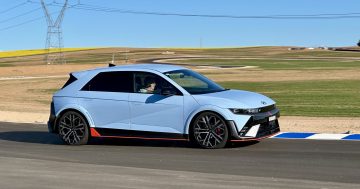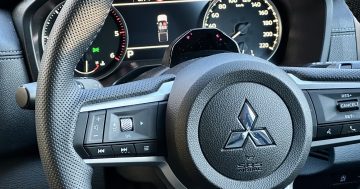
The Hyundai i20 N on the boat ramp at Stirling Park in Yarralumla. Photo: James Coleman.
It has been a very long time since I last drove a manual. And at a tender time like this, what you do not want is stop-start city traffic. That is a recipe for stalling and stalling is up there with streaking when it comes to causing red-faced embarrassment.
A failed take-off is excusable if the car in question is a standard Hyundai i20, but this is the all-new N version. It has a large wing at the back, side splitters dipped in red, and an exhaust note that is probably rattling picture frames in the nearby apartments, all of which implies it is a car for people who know one end of an anti-sway bar from the other and can’ heel and toe’ balletically.
I hope I get there, but for now, it’s off to Yarralumla.
Yarralumla might be better known as the home of the Old Brickworks, the Governor-General and kebabs as big as your arm, but it also borders Lake Burley Griffin. Canberra might not have a real beach, let alone a Great Ocean Road, but Alexandrina Drive comes darn close.
The road is largely quiet, narrow and riddled with tight corners, with the occasional glimpse of water through the trees. This is more like it. This is hot hatchback territory, manual or not. And one thing becomes immediately clear – the i20 N is a serious bit of kit.

Double trouble. Photo: James Coleman.
Hyundai’s performance sub-brand ‘N’ is named in joint honour of their headquarters in Namyang in South Korea and their testing facility at the Nürburgring race track in Germany. We first saw it on the i30 hatchback in 2016 when Hyundai pulled off an impossible feat with their first attempt. Critics over the world agreed – everything was spot-on.
Before you think this slightly suspicious, Hyundai did manage to enlist the help of a long-time veteran of BMW’s M performance division, Albert Biermann. I imagine that to Biermann’s German mind, the fact that N alphabetically follows M may have sweetened the deal.
Last year, the i30 N was treated to updated light graphics and a new dual-clutch automatic gearbox. Almost at the same time, a raft of new N models arrived, with the now hallowed badge coming to the i30 sedan, Kona, and i20.
It was only a matter of time for the i20, the smallest and cheapest of these. Since 2014, Hyundai has been undertaking real-life research on the rally stage at the World Rally Championship (WRC), and their weapon of choice was none other than the i20.
And you can see why. The best chance you have of making something move is for it to be small and powerful. The i20 N weighs just over a tonne and has a 1.6-litre turbo petrol engine that produces 150 kW. Hyundai claims a 0-100 km/h time of 6.7 seconds.
So the basics are nailed, but it doesn’t stop there. You almost don’t care how fast it is on paper, because the rest is an addictive game.
Blue tabs on the steering wheel provide shortcuts to ‘N mode’. You can adjust the throttle, steering, suspension, and exhaust through the main screen so that when you hit the blue tab the next time, it goes straight to your preferred setup.









You’ll be in ‘N’ most of the time just so you can hear that exhaust, to be honest. It’s also accompanied by a lap-timer, G-force graph, and a display for the percentage of brake and throttle pressure at any one time. Geeky, but pleasing. The sports suspension not so much – it can be incredibly jiggly.
To help novices like me who can’t ‘heel and toe’ (I had boots on, OK), there is also a rev-matching function to assist with bringing the revs up while changing down. In the development meeting, when deciding on what this particular button should look like, clearly someone stood up and said, “Make it big and red and put it on the steering wheel”. So they did. That’s terrific.

Inside the N, complete with a big red button. Photo: James Coleman.
It also has launch control, which means you can just dump the clutch and rocket forward without any fear of stalling.
Mind you, there is so much power and torque on offer, you’ll be rocketing forward a lot without flustering the engine at all. Then it’s over to the handling, which is astonishingly tight and controllable.
This is what you expect supercars to be like, not dinky little hatchbacks.
You might think they’ve gone a bit far with that wing on the back, especially when Hyundai tells you it is there to provide additional downforce in cornering. But you don’t wear the i20 N like a handbag. You don’t buy it because it has Apple CarPlay or because it’s a bit ‘nippy’, or because it has ‘Blind-Spot Collision Warning’. You buy one because you love driving.
It has a manual gearbox, for goodness sake.

The i20 N is a car for serious drivers. Photo: James Coleman.
Hyundai i20 N
- $32,490 (plus on-road costs)
- 1.6-litre turbo petrol, 150 kW / 275 Nm
- 6-speed manual, front-wheel drive
- 0-100 km/h in 6.7 seconds
- 6.9 litres per 100 km combined fuel usage
This car was provided for testing by Hyundai Australia. Region Media has no commercial arrangement with Hyundai Australia.





















